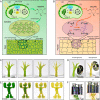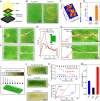Photosynthesis-assisted remodeling of three-dimensional printed structures
- PMID: 33431680
- PMCID: PMC7826334
- DOI: 10.1073/pnas.2016524118
Photosynthesis-assisted remodeling of three-dimensional printed structures
Abstract
The mechanical properties of engineering structures continuously weaken during service life because of material fatigue or degradation. By contrast, living organisms are able to strengthen their mechanical properties by regenerating parts of their structures. For example, plants strengthen their cell structures by transforming photosynthesis-produced glucose into stiff polysaccharides. In this work, we realize hybrid materials that use photosynthesis of embedded chloroplasts to remodel their microstructures. These materials can be used to three-dimensionally (3D)-print functional structures, which are endowed with matrix-strengthening and crack healing when exposed to white light. The mechanism relies on a 3D-printable polymer that allows for an additional cross-linking reaction with photosynthesis-produced glucose in the material bulk or on the interface. The remodeling behavior can be suspended by freezing chloroplasts, regulated by mechanical preloads, and reversed by environmental cues. This work opens the door for the design of hybrid synthetic-living materials, for applications such as smart composites, lightweight structures, and soft robotics.
Keywords: 3D printing; photosynthesis; self-healing; self-remodeling; self-strengthening.
Conflict of interest statement
Competing interest statement: The University of Southern California has filed a patent application related to the work described here.
Figures





References
-
- Popper Z. A., et al. , Evolution and diversity of plant cell walls: From algae to flowering plants. Annu. Rev. Plant Biol. 62, 567–590 (2011). - PubMed
-
- Ashby M., “The CES EduPack database of natural and man-made materials” (Cambridge University and Granta Design, Cambridge, UK, 2008).
-
- Shah D. U., Reynolds T. P. S., Ramage M. H., The strength of plants: Theory and experimental methods to measure the mechanical properties of stems. J. Exp. Bot. 68, 4497–4516 (2017). - PubMed
Publication types
MeSH terms
Substances
LinkOut - more resources
Full Text Sources
Other Literature Sources

